The Bio-Psycho-Social Aspects of Gender and Sexuality
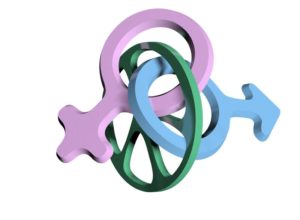 In this article I want to explore the idea of fixed and fluid gender traits and roles. As a trans-gender person I have had an amazing opportunity to experience the world and my interactions within it as female and as male – and just about everything in between. I use the term trans-gender to describe the process I have taken, starting in my early 20’s with a bilateral mastectomy and a life-long process of hormone treatment. At the time, this was mostly understood as ‘gender reassignment’ – going from female to male.
In this article I want to explore the idea of fixed and fluid gender traits and roles. As a trans-gender person I have had an amazing opportunity to experience the world and my interactions within it as female and as male – and just about everything in between. I use the term trans-gender to describe the process I have taken, starting in my early 20’s with a bilateral mastectomy and a life-long process of hormone treatment. At the time, this was mostly understood as ‘gender reassignment’ – going from female to male.
From as early as I can remember, however, I have considered myself to be not just a single gender. At the time this was termed ‘androgynous’. More recently with the explosion of the gender spectrum there are now many more words to describe people who identify as I do. One more recent term is ‘gender-fluid’. Gender-fluid is more fitting for me personally and, as you will come to understand as you read this article, I believe we are all inherently biologically gender-fluid.
The developing understanding of Gender and Sexuality
We now have a better understanding of the difference between gender identity (how you think about yourself`), expression (how you present, dress, act and behave), sexual preference (who you are sexually and romantically attracted to), and anatomy (your anatomical body). These different aspects are correlated and I believe they can all be affected by changes and fluctuations in hormones, experience and context. However, if we see these 4 aspects as sliding scales, we can generally identify where we spend most of our time. I believe that we not only change our positioning on these scales on a regular basis, but that this process is a biological adaptation for the survival and growth of our species.
For the purpose of this article, I am specifically exploring work of Dr. Ryke Geerd Hamer and his observations of the impact of trauma ‘survival events’ that affect specific areas of the Cerebral Cortex. In particular I want to share my thoughts about the way in which specific conflicts create a change in hormones in the brain that lead us to perceive events and situations differently. The purpose of this perceptual alteration is to change our survival strategy.
These changes can impact our gender identity, gender expression and even our sexual orientation to assist us in adopting the best survival and social strategy for ourselves and for the group. There are different aspects to the survival of the species, including the continuation of procreation, the protection of the group or tribe from external danger and the growth and harmony of the group within the tribe.
Dr. Hamer noted that a person’s gender, laterality and hormone status significantly impact the individual’s perception of an event. He discovered that, depending on the perception of an event, the organ-brain-psyche organised the adaptation in a specific way, for a very specific response.
Put simply, when a male and a female witness the same event, their perception will be different due in part to their male-ness and their female-ness. Their response to meet the demands arising in the situation would be different; therefore the organ tissue response differs.
The Brain and Hormones
The production of sex hormones such as estrogen and testosterone occur primarily in the sexual organs, namely the ovaries and the testicles. However, hormone levels are also controlled from the brain. In both men and women the status of estrogen is controlled by the left hemisphere and the status of testosterone is controlled by the right hemisphere.
When these parts (or ‘relays’) of the brain at this Cerebral Cortex level are impacted by a significant emotional event – a ‘threat to survival’ – information will be organised on biological, psychological and social levels. Correspondence between the brain, the psyche and the organ makes the optimum choice to provide the most effective biological survival strategy.
So, in its simplest terms, a female perception will impact the tissue required to assist a ‘female’ response, and a male perception will impact the tissue required to assist a ‘male’ response.
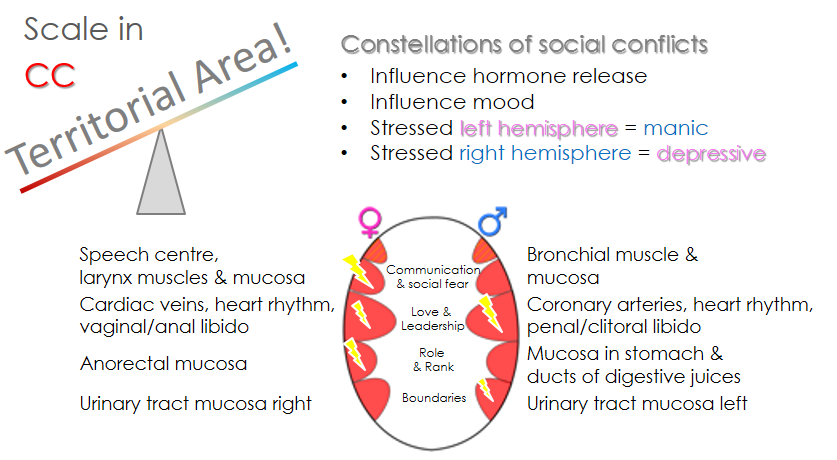
The tissues of the body controlled by the cortex left hemisphere are:
- temporal lobe; laryngeal muscle/vocal chords, larynx mucosa, coronary vein/muscle, cervix uteri, rectum mucosa, renal pelvis mucosa, ureter, urethra
- frontal lobes; thyroid excretory ducts
- Glucose centre; Alpha lslet cells (Glucagon)
Female perceptions are more internal or nest-oriented such as: powerlessness, helplessness, fright/speechless, sexual frustration with not being able to mate with the right male, female identity or decision conflict, inability to define inner boundaries or to know one’s position, fear with disgust (often sexual).
The tissues of the body controlled by the cortex right hemisphere are;
- temporal lobe; bronchial muscle, bronchial mucosa, coronary arteries, seminal vesicles mucosa, small curvature of the stomach, liver bile ducts, pancreatic ducts, bladder mucosa, ureter, urethra.
- frontal lobes; branchial/pharyngeal duct mucosa
- Glucose centre; Beta lslet cells (Insuline)
Male perceptions are more external and boundary-oriented such as: fear of frontal attack, territory fear, territory loss, not able to discharge enough ejaculate, territory anger, territory marking, resistance and defense against attack.
Male and Female Territories
I have 2 short stories that I can share to define basic gender perceptions regarding territory:
 1. When toilet training our schnauzer puppies we began to encourage them outside for their ‘business’. I noticed that as they began to learn to pee outside, the boy, Nero, even before he began to cock his leg, would push his bottom right up to the fence and shoot his pee up and outside of the fence. He was spreading his scent around the boundary and even further out of the boundary to mark his territory and keep intruders as far away as possible. However, the little girl, Bianca, would squat around the inner edge, sometimes in the middle to define her territory as play area, she did not need to defend the perimeter.
1. When toilet training our schnauzer puppies we began to encourage them outside for their ‘business’. I noticed that as they began to learn to pee outside, the boy, Nero, even before he began to cock his leg, would push his bottom right up to the fence and shoot his pee up and outside of the fence. He was spreading his scent around the boundary and even further out of the boundary to mark his territory and keep intruders as far away as possible. However, the little girl, Bianca, would squat around the inner edge, sometimes in the middle to define her territory as play area, she did not need to defend the perimeter.
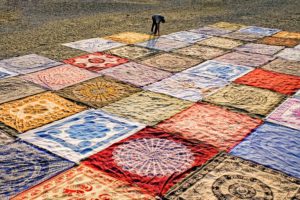 2. One summer afternoon my husband, Vic, and I were going with the family to Hove beach. It’s pebbly and a bit uncomfortable, so I took about 4 big blankets thinking that this would soften the ground and make for a nice base for us and the children to ‘nestle into’. One of the kids wanted an ice-cream so I went to the shop leaving Vic to spread out the blankets. When I returned he had spread out all 4 blankets next to each other in one big square creating a vast expanse of space to ‘spread out on’.
2. One summer afternoon my husband, Vic, and I were going with the family to Hove beach. It’s pebbly and a bit uncomfortable, so I took about 4 big blankets thinking that this would soften the ground and make for a nice base for us and the children to ‘nestle into’. One of the kids wanted an ice-cream so I went to the shop leaving Vic to spread out the blankets. When I returned he had spread out all 4 blankets next to each other in one big square creating a vast expanse of space to ‘spread out on’.
It immediately struck me how the male solution to the problem was to create a large territory, with expansive boundaries, whereas my solution was to make a close, cosy ‘nest’ for us to huddle into.
These are simple examples and of course there was no threat. But I do think they show how, if faced with a threat, a male solution may be different from a female solution.
Male and Female Perceptions to an Event
The same event has different meanings to us all, based on our experiences and the meaning we give to things. Part of what forms this opinion is our hormone and gender status. The same event to a male animal will instigate a ‘male’ response and for a female animal will trigger a ‘female’ response. Here is a simple story I have used to exaggerate the male/female perceptions based on primal gender roles:
A husband and wife were fast asleep in bed one night when they were suddenly awoken by a loud noise downstairs. The man leaped out of bed, grabbed a nearby baseball bat and set off downstairs, in his pyjamas, to see what the commotion was. The wife hurried into the children’s bedroom to huddle with them beside the bed, in case the danger came upstairs. The brave and perhaps foolish man came face to face with a fearsome burglar, who proceeded to beat the man up before making off with his TV and DVD player. On hearing the commotion downstairs, the woman was very afraid, but could not cry out for fear of attracting violence.
Both the man and the woman experienced their initial territorial traumas.
The man perceived a threat to his territory – his house, his family, his belongings – and so experienced a male, territory-fear conflict. He needed to square up to the invader, so this triggered the part of his cerebral cortex on the right hemisphere (the male side), associated with the bronchial mucous membranes. This is because the mucous membranes in the bronchi thin in the event of a territory fear, in order to allow more air in and be ready for a fight. This thinning occurs in the stress phase.
Unfortunately, the man failed to resolve his territory-fear conflict because he was defeated. This left him with an active conflict in the right hemisphere. The right hemisphere (associated with the bronchial mucous membranes) is the side that also controls the production of male hormones. When the conflict remains active, the production of hormones is inhibited. This inhibition of hormones will subtly change his perception and behaviour .
The woman was unable to cry out to raise help to protect herself and her children – this is a female, territory-fear conflict. This conflict causes a thinning of the larynx’s mucous membrane, in order to dilate the throat and allow for better breathing and the ability to scream. The area associated with the larynx’s mucous membrane – also associated with not being able to cry out – is in the left hemisphere of the cerebral cortex. Because her natural strategy of crying out for help and alerting others to danger could not be achieved, the woman is left with an unresolved conflict in her left hemisphere. Her left hemisphere is the side that controls the production of female hormones and this is now inhibited. Suppressing the release of female hormones will change her perception and her behaviour in the future.A few weeks later, the couple received their insurance money and replaced their stolen goods with nice, new ones. They stacked the boxes outside by the bin, which allowed the observant burglar to see that they now have new equipment. Back in bed that night, the couple heard a noise downstairs … What do you think happened?
The man (who is now reacting with a more feminine energy because of his reduction in production of his male hormones) slides down under the covers, thinking, ‘Well, I’m not going down there again; I got beaten up last time; I will wait here until he has gone.’ The woman on the other hand (who is now reacting with a more masculine energy because of her reduced production of female hormones) thinks, ‘I’m not having this stranger coming into my home, threatening my family and taking our things.’ She grabs the baseball bat and storms downstairs to chase away the burglar!
In both cases, the active, unresolved conflict created a new behaviour that assisted in resolving the issue next time in a different way.
Although this is a simple story, it demonstrates the way in which conflicts in the cerebral cortex can affect our perceptions and our behaviours.
The more conflicts that impact on one side of the brain, the more hormone production on that side will be inhibited and the greater the shift in perception and behaviour.
Broadly speaking, the male ‘outward energy’ become more depressive and inward and the female ‘inward energy’ became more aggressive and outward. Understanding these territorial perceptions is critical to understanding and working with depression and bi-polar issues.
(METAMessages From Your Body – Understand the cause of disease and why the body doesn’t make mistakes, IntoAlignment Publishing 2016)
Changing Your Perception and Modifying Your Strategy
When the impact of a significant emotional event affects the specific tissue required to adapt in the moment to the perceived threat, a shift occurs in the secretion of the hormones corresponding with that side of the brain. This shifts the hormonal status and updates perception to be better prepared for the next time a similar threat occurs. This shift is proportional to the event – so a small shock/conflict impacts in a small way and a big shock/conflict has a bigger effect. However, a number of smaller conflicts in any of these specific areas can add up and contribute to a greater shift in hormones. (We do not produce more male or female hormones, but when one is suppressed, we operate more from the other hormones.)
So what happens if your initial strategy does not work?
It seems our biology affords us a second chance to see things and therefore to do things differently.
When we talk about gender, traditionally we talk about the polarity of male -‘the Masculine’ – and female – ‘the Feminine’.
At its most fundamental biological level of interaction, the opposites of male and female combine to procreate and make a baby. This baby is either a male or a female and goes on to continue the species by meeting another of the ‘opposite sex’ and so on and so forth. The species continues by virtue of the egg and sperm and the wonders of nature.
It has long been observed in the animal kingdom that together with this most basic partnership, animals also exhibit common biological traits that are considered both male and female. Most obviously it is the female that gives birth to the baby. The mother will spend a period of time pregnant, giving birth, feeding and nursing the baby and during this time she and the baby are vulnerable. The supportive role of the male is then to guard, bring food and keep the nest, mother and baby safe from predators, the elements and any danger or harm.
Through scientific observation we have been able to observe biological and psychological features of men and women that assist these basic roles, within couples and by extension within the social group. With the imperative to continue the species, a biological balance developed where males became better focused hunters, more aggressive defenders and fighters and developed behaviours to display their ability to protect and be strong and spread their seed. Females meanwhile displayed their nurturing skills, their feeding, soothing and peace-keeping abilities within the group.
Biologically, the man needs to spread his seed and the woman needs to receive his seed, incubate and nurture the seed into a baby. Scientific developments aside, this is still the case in the human animal kingdom for the continuation of the species.
Tend or Defend
When we see these extreme gender differences in the animal kingdom, we are less inclined to give ‘meaning’ to these traits. However, when we look at the human animal, we tend to give meanings, assign them as ‘roles’ and define male and female ‘strengths’ and ‘weaknesses’.
With the passage of evolution gender and sexuality have also transformed in the animal kingdom. Nursing mammals and the evolving herd or social group moved behaviours way beyond. a simple biological coming together of sperm and egg. The blending of male and female energies has governed the structure and energy of the group and has influenced social harmony. We are not only designed to procreate, but also have grown to live in balance and harmony and to live socially in a network support group that meets group needs. These needs for survival and safety, cannot be met by one animal alone, but are collectively managed and sustained by group cohesion.
It is important to emphasize that these male and female traits have worked TOGETHER, in balance and in support of each other to form a partnership. As life challenges occur, so roles and responsibilities can change and modify. In this perspective, one can never be fully at the male or female end of the spectrum. Procreation aside, we can never be fully male or female. In trying to force polarity upon us, society has totally missed the point of partnership and social balance.
Social Engagement and Safety
Stephen Porges has changed our understanding of trauma treatment by defining the different aspects of the autonomic response to stress and trauma by recognising the importance of social engagement for safety and vagal regulation. Our primary biological need is to feel safe and, as group animals, we achieved this best within our group. Connection, acceptance, belonging and support within our tribe gives us safety.
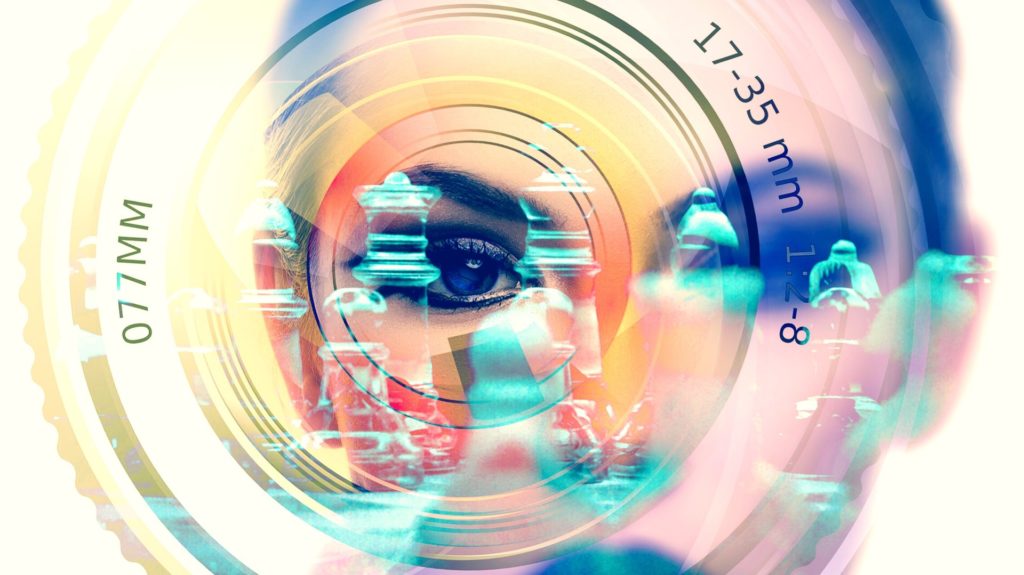
When we think of the role and fundamental traits of male and female we can see the way in which these two energies in their extreme work together. However, a group is never decided by extremes, and holds within it the full spectrum of energies and traits to maintain this balance and harmony. The ‘Alpha Male’ – so called because he is at the peak, the ‘top dog’ – is said to be the ‘leader’ of the pack or group. He is seen to dominate and control the direction of the group, have his choice of any (or all) of the females and can determine the behaviour of the other males, who give way to him if they lack the ability to claim his ‘alpha’ role. Every once in a while the Alpha male is challenged by a rival, often a younger male, seeking to claim the male role.
If we understand the discovery Dr. Hamer made about the suppression of male and female hormone secretions in the left and right cortex of the brain, we can see here the operation of a fundamental biological reason why significant hormonal shifts occur as a result of specific events and conflicts.
If a male challenges another male and wins, he will have no unresolved conflict because he succeeded in his goal. He will be filled with male hormones that continue his ‘maleness’. However, the loser will have an active unresolved conflict and, for the good of the group, and indeed himself, he will take his place lower down the pecking order of the group and his lesser male energy will balance within that spectrum. There is no right or wrong, good or bad, best or ‘not good enough’. There is the balance of the group. A group with the same goal of survival and continuation of the species has an unwritten agreement that the strongest will lead and the rest will fall in place. The strongest hunter and protector, fighter and defender will lead the group. The activities of the beta male and the other males of the group are just as important. The Alpha male, having proved himself to be the strongest is biologically acknowledged to be the one to spread his seed among as many as possible to create the fittest possible offspring and to create the strongest group going forward. This is survival; a straightforward biological imperative.
The Alpha female is not the aggressive and dominant woman but quite the opposite: the gentle, nurturing, forgiving and apparently helpless female who needs a strong male to take care of her. She is the multi-tasking, group harmonising, bosom of the family who tends and takes care in the nest. These ‘extremes’ of male and female energy are only a part of the spectrum and are only required when conception is the goal. (There are numerous studies that show that women are more attracted to manly men when ovulating). The rest of the time ‘life is happening’ and we are engaged in many, many other activities.
The Global Tribe
Although these behaviours are easier to see in a smaller group or animals or tribe, there is an increasing need to look at the balance of energies in our ‘global tribe’. Whether it is the female suffrage, decriminalization of homosexuality, war on terrorism or protesting for peace, there is a huge imbalance in male/female energy. Some of these approaches fuel this imbalance, and some re-dress it.
There is an increasing epidemic of reported sexual harassment and inappropriate sexual behaviour, mostly towards women and most often in the work place – why is this?
Some say that it has been going on for a long time and people are only just speaking up about it now, and this of course may be true. However, if we look at the difference between the animal and the evolved ‘human’ there are some clear animalistic behaviours that as ‘evolved humans’ should be able to identify and surpass with developed critical thinking. However, when we are threatened we do not have cortical function and we tend to revert to our most fundamental survival responses; fool around, flirt, flight, fight or freeze.
We have evolved to hold values, exercise judgments and to ascribe ‘meaning’ to behaviours and appearances. ‘Inappropriate’ sexual behaviour, bullying and dominance are animal traits to which human society ascribes meaning. We value respect and we abhor bullying and discrimination, and yet in fear we adopt our basic needs for survival. For men who feel challenged or threatened in the workplace, it is a reversion to assert one’s maleness in an animalistic way. Everyman has the mechanism to do that, but the higher evolved man, more secure and safer in himself, will have a higher cortical function and will not resort to or even entertain this animalistic behavior in the face of challenge.
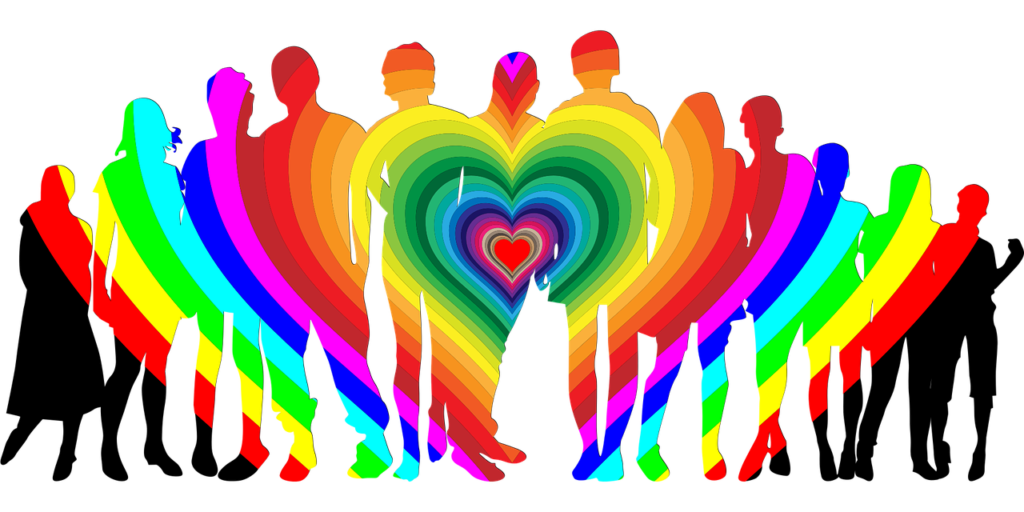
It may be more effective if we consider dominance, bullying and disrespect for anyone for any reason, including gender and sexuality, as arising from a fear-based trigger. Seen in this way we may use our perception to better understand these undesirable behaviours and to promote respect, support and inclusivity in the workplace and in our social groups.
To demonize bullies and the perpetrators of sexual harassment does not solve the underlying problem. It is not enough to point the finger and to ascribe blame. What is needed is an evolution of consciousness, to develop an awareness of the ‘sliding scale’ of gender roles in a changing society and to encourage de-escalation of the fear and frustration that motivates the ‘un-evolved’ perpetrator of bullying and sexual harm.
Diversity is a necessary feature of creativity
Both male and female have both male and female traits, skills and potentials. As creative biological beings, although we may have a gender bias, we also have the innate ability to adapt and change to our environment – not just for our own survival, but for the survival of the group.
I once heard someone ask how being gay helps the continuation of the species. There is a good answer to that: whilst the aggressive ‘male’ men fight to the point of extinction, an increase in a more feminine energy promotes the nurturing that we need as a society to negotiate peace and to promote understanding.
The animal alpha male answer to the fear of extinction is to fight and to procreate. For an evolved ‘humane’ animal it is to create safety, support, inclusion and harmony. Our planet is in dire needs of this kind of transformation.
The protector and defender role has been taken to the extreme of Mutually Assured Destruction – M.A.D. – and the constant bombardment of ‘cortex conflicts’ caused by the overbearing ‘male energy’ in territorial wars and territorial fear is causing a shift in the birth and evolution of more gender fluid, gender ‘savvy’ peacemakers and healers.
Honouring the Animal
In his masculine energy, man has taken dominance and competition and (albeit with good intention to protect and provide) has created a masculine economy, a masculine religion, a masculine workplace and a masculine-dominated society. In this imbalance, women were kept in the home to have babies and tend the nest. Within the dominant global culture (though not in all cultures and not every man!),’man’ got lost in competition and in the biological drive to provide and to protect. It seems as humans we came only to value these basic traits of strength and domination. In that struggle we have lost the whole picture. The whole picture is much more balanced, but as man perpetuates territorial issues and inevitable territorial trauma, our species will be forced to re-dress the balance and to evolve. In response, gender fluidity will also evolve.
In truth, the whole picture is that both men and women can shift within the gender spectrum and can use qualities from that range to adapt to any given situation. A man can tend the nest and a woman can earn the income and protect the family. Gender roles and sexuality are fluid in the animal kingdom.
If you don’t believe me check out the amazing book by Bruce Bagemihl, Ph.D. called ‘Biological Exuberance – Animal Homosexuality and Natural Diversity’ which is a documented catalogue of animal species that clearly display natural gender diversity.
The Gender Chameleon
Our roles were never meant to be fixed. We seem to have evolved the cerebral cortex that gives us our critical function, but not enough to honour the animal part of us so as to combine physical, mental and emotional awareness with our higher thinking. The abuse of power has forced our hand. Whereas it is in our nature to glide gracefully up and down the gender spectrum, maintaining balance and harmony, the suppression of feminine energy has caused a backlash and that balance has to be redressed. Active trauma in the female energy is allowing women to rise to more aggressive levels and active trauma in male energy is suppressing the male population. These shifts create diverse and critical components of a global transformation. You can blame the hormones in the water, or the tofu, but the bigger picture is that if we do not resolve these traumas, we will need to adapt to find a new balance and a better way.
Gender diversity is a birthright and a critical function of social balance
It has always been a natural part of the functioning of social animals and we are now coming to realize that the social construct created to glorify the Dominant Masculine was never a natural condition and is beginning to disintegrate. Both men and women have the full capacity to utilize their male and female energies and by extension to adapt their male and female roles. Specific roles were never meant to be exclusive to a single gender or to penalize and abuse those that do not adopt them.
As we have developed into more complex beings, our need for tribal and territorial interaction has increased. Our need to bond with our group for safety has developed into far more than a physical safety from external danger. Within our group we develop our purpose in life. Our safety and acceptance arising from the group now also affords us the support to self-actualize and to find and fulfill our soul-purpose. A threat to survival is no longer a physical threat, but can be experienced as a threat to my self-identity – ‘who I am’ in the world. Therefore, it has become vital to our survival to be flexible in the face of such potential threats.
Conclusion- A Global Energetic Shift
We are highly evolved beings with creative bio-intelligence. Although we are human, we are also animals. We must remind ourselves and each other that we are ‘humane’ and, although we have animal instincts, we have the capacity to self-regulate, to reason, to think and to evolve. Our fears are our inheritance from very old programmes. Although they may have been formed to serve us somewhere in our past, they are ours now to evolve and to grow from – this is the nature of evolution.
In the past, we have labeled gender, gender roles and sexuality and have created a structure by which to define our place within the framework. But, if the structure becomes a straightjacket, a tool for judgment and exclusion instead of inclusion, it is time to move beyond.
Gender and sexuality are on a fluid spectrum. Every day, depending on the context, we adapt to make best of a situation. If we are in fear, or our needs are not being met, we may respond in a specific way, if we are comfortable and safe, we will respond differently. When we respond personally we can never detach from the social impact.
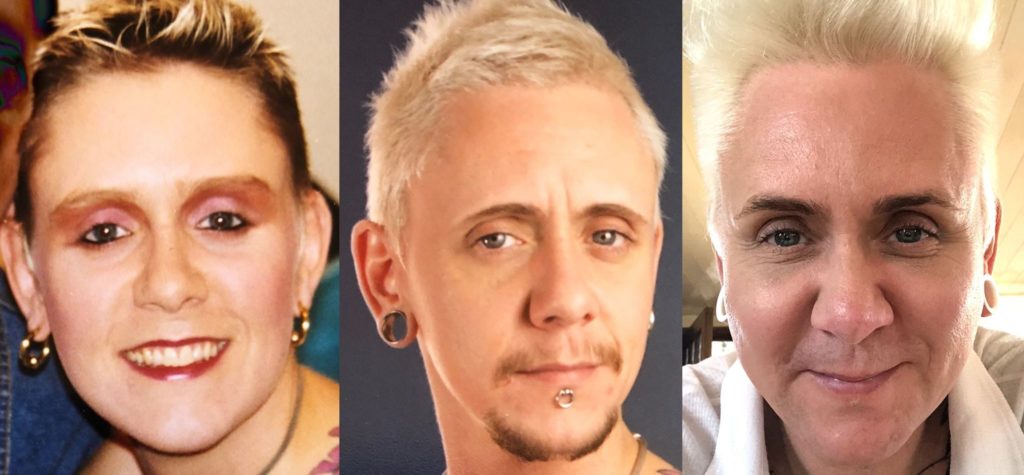
I have been so fortunate to understand what if feels like to have extreme female and male perceptions, and I definitely feel I understand men better than most women ever get a chance to do. I have witnessed female and male traits in the extreme and even went through phases of being a sexual deviant and an aggressive alcoholic (maybe more on that another time). I have learned so much about extremes and about balance. I like to think have been able to use my understanding to navigate the gender playground and support people who struggle to feel that they fit in and those that struggle to break their gender conditioning.
I did enjoy this presentation ‘A Tale of two Brains’ by Mark Gungor:
He does ham it up a bit and exaggerate gender differences, but really his point is, one is not better than the other – they simply work differently and together they bring balance.
We have developed the capacity to make choices. However if we do not make the choices that work for the greater good, we have a way of adapting biologically to redress and maintain social balance and as a result, eventually, to achieve ecological and global harmony.
Sadly it’s a bit of a long game. However, the more we embrace our biological intelligence and are wise to our needs and our survival reactions, the more we can work on what triggers us and causes us to act in ways that cause harm. Only hurt people hurt people. An inclusive, supportive and compassionate global community is the only way forward.
This article is an excerpt of Sam’s new forthcoming book “7 Steps to Conscious Health – Believe in Your Power to Heal”
Learn more about biological programming and how it can relate to mental and physical dis-ease to help the World be META-healthy!
References:
METAMessages From Your Body, Sam Thorpe 2016, IntoAlignment Publishing;
Biological Exhuberence, Bruce Bagemihl, Ph.D. St. Martins Press 1999.
You can explore more about the different aspects of gender and sexuality at www.intrpronouncedmetrosexual.com and the different terms at
www.stridentconservative.com/gender-and-sex-defining-our-terms/
A Tale of Two Brains, Mark Gungor https://www.youtube.com/watch?v=fTPUhMdfvzw
pictures:
https://www.stockfreeimages.com/29811211/Gender-Symbols.html
https://pixabay.com/en/predator-tiger-man-fear-view-2217941/
https://pixabay.com/en/technology-abstract-photography-3038005/
https://pixabay.com/en/family-love-rainbow-boy-child-2112266/
Sam Thorpe
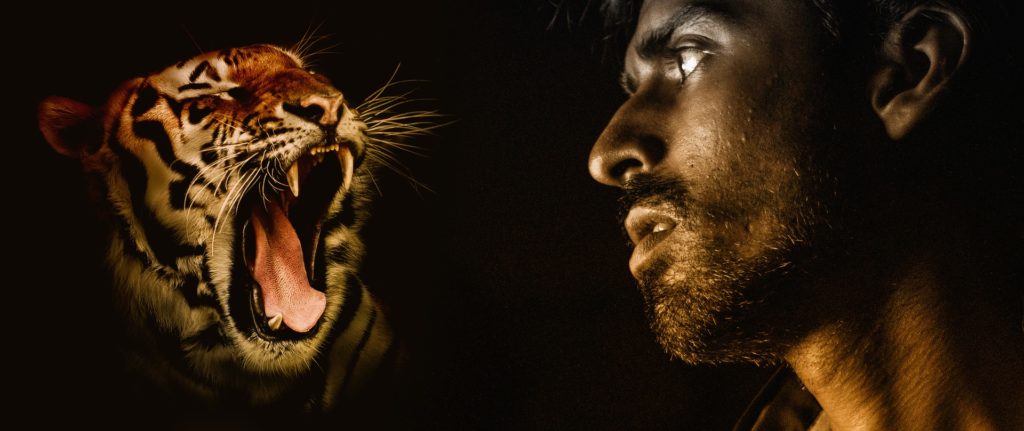

 META-Healthy Life articles are created by professionals and friends of META-Health International CIC, supporting individual and global health by deepening and sharing our understanding of how resilience and well-being are achieved.
META-Healthy Life articles are created by professionals and friends of META-Health International CIC, supporting individual and global health by deepening and sharing our understanding of how resilience and well-being are achieved.